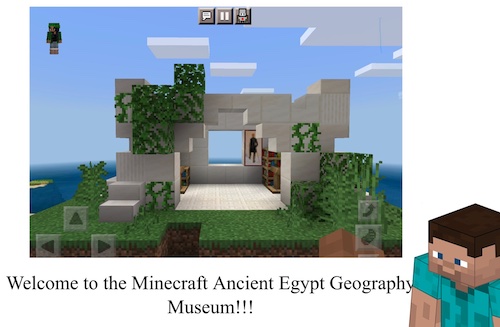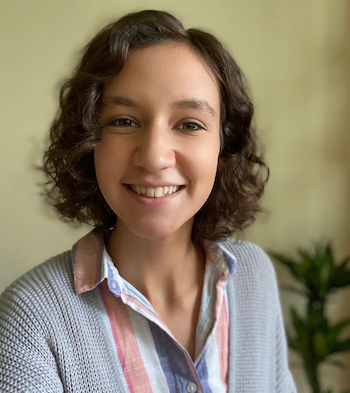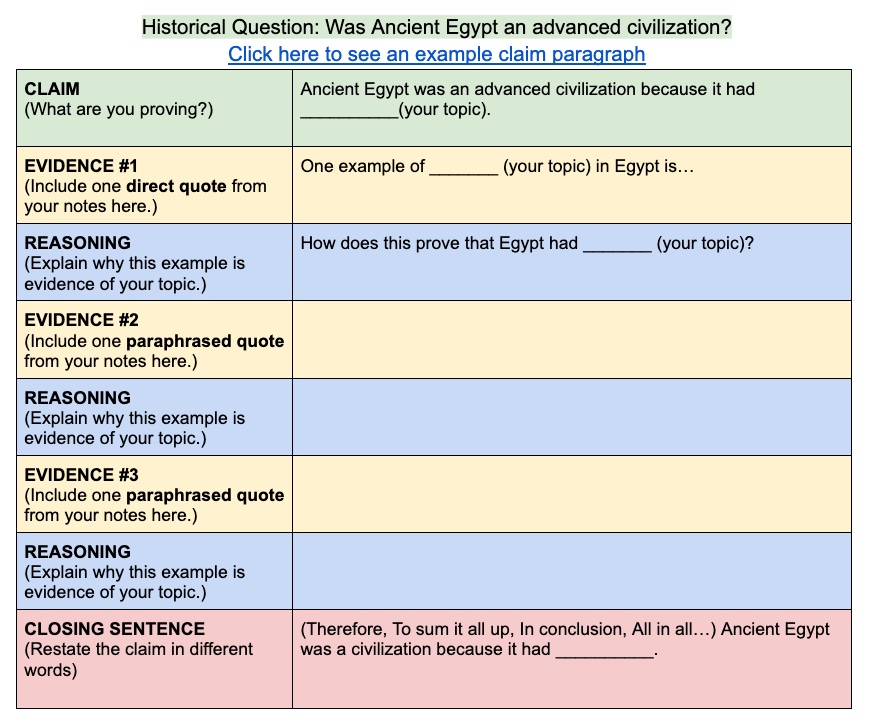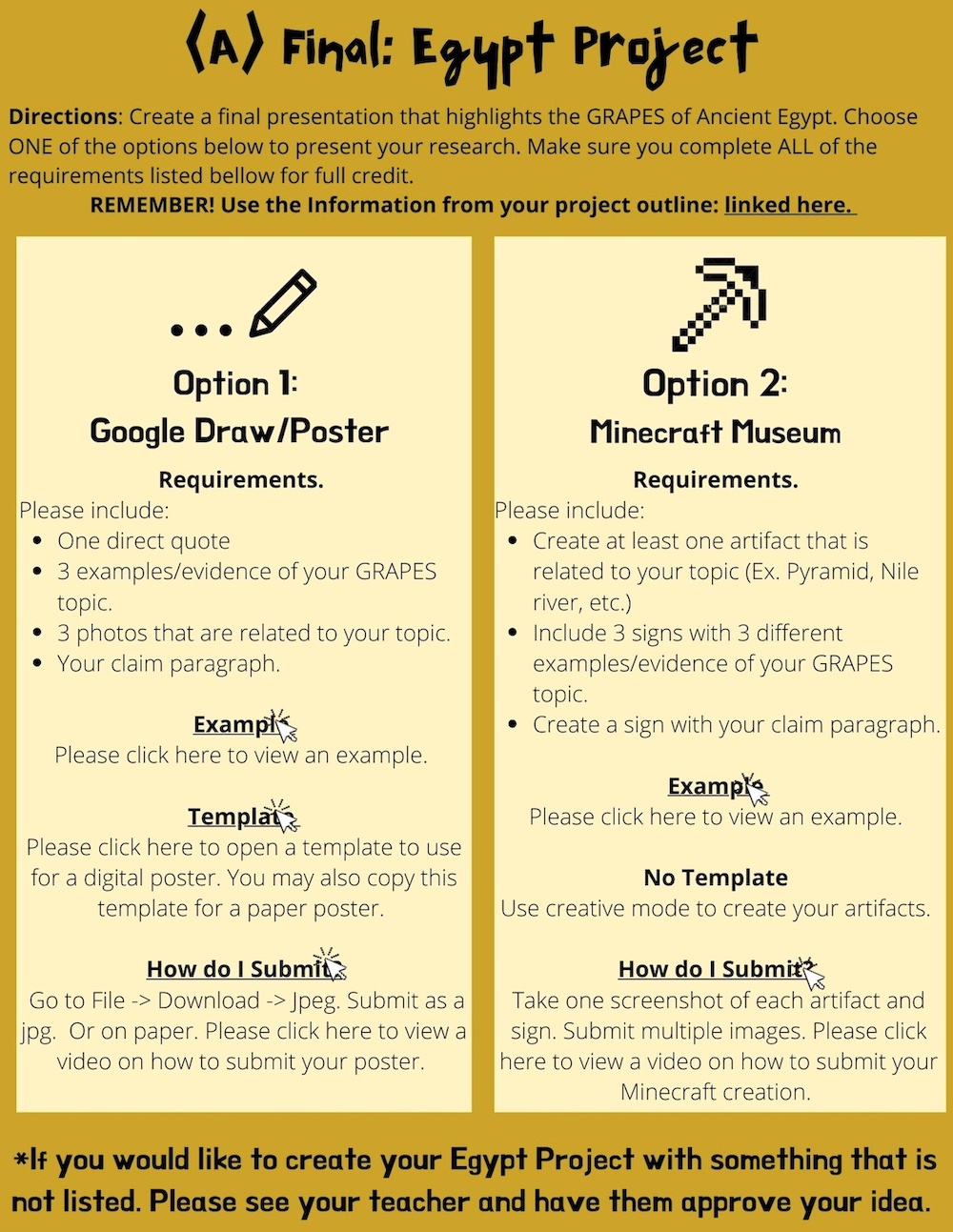Using Minecraft to Present Evidence-Based Claims in Ms. Wenzel's Class


As an English teacher, I am always looking for creative ways to get my students excited about writing. If you have any experience teaching writing to middle schoolers, you have an idea of just how difficult of a feat this can be. However, a fabulous colleague of mine, Ms. Laurel Wenzel, was able to bring new energy to the writing process by encouraging her students to represent their evidence-based claims through the world of Minecraft. I sat down with Ms. Wenzel to learn a bit more about her integration of Minecraft into the writing process in her sixth grade world studies classes.
Can you tell me a little bit about yourself and what you teach?
I’ve taught sixth grade world studies for three years. I've also in the past taught science and art, which has been fun. This is my third year teaching at Argyle, and I’ve only taught sixth grade.
What do you love most about teaching 6th grade world studies?
I’ve taught three subjects now but world studies is my favorite because it can be so creative and hands-on. So there's just a lot of opportunities to play games and simulations, which I really love. I think it's really, really engaging. Especially with sixth graders because they're so into that. . . . They're still kids, they want to have fun, but they can also have those serious conversations that world studies requires too so it's just like the best of everything––the best combination.
What specific world studies disciplinary skills do sixth graders need in order to be successful and meet world studies standards? What kinds of literacy do they practice in world studies classes?
 Claim paragraph outline used in Ms. Wenzel’s classes.
Claim paragraph outline used in Ms. Wenzel’s classes.
So in world studies we focus on claim writing, so we're using evidence and reasoning to support our historical claims, and they're using primary and secondary sources to support those claims. That's really what we focus on the most. And then we also try to incorporate and encourage collaboration skills and being able to have those discussions with each other. So it's not just writing with those skills, it's discussing and verbalizing those skills as well.
I've heard that you've been able to incorporate some very cool digital platforms––specifically Minecraft––as assessment tools for your world studies classes. Can you tell me a little bit more about how you were able to integrate Minecraft into your instruction and the inspiration for that integration?


 Student-made artifacts created in Minecraft to support their claim paragraphsI'm always just looking for creative ways to just engage the students because our
students have a lot of skills and interests, and I want to be able to hit all of that
for my diverse group of students. And they request minecraft a lot, so I wanted to
deliver on that. We use it mostly in world studies as a presentation tool. That's
the easiest way I found to implement Minecraft, but there are other really cool ways
to use it. In science we've done like … they're kind of like escape rooms. In Minecraft
you can just send them the link and let them go, and they can collaborate with it.
But for big projects … we use it as a presentation tool. We do it about four times
a year. It's always an option for them to present [with Minecraft]. Instead of just
PowerPoint and posters, Minecraft is our other option, and I think it really excites
the kids and gets them engaged in the process. But we always use it for when we're
doing claim, evidence, reasoning. So they have to write their claim, and they do all
this research for it every quarter for each topic. And then they have to present that
claim somehow to their audience. So Minecraft is one way for them to kind of curate
their evidence and show what they've learned.
Student-made artifacts created in Minecraft to support their claim paragraphsI'm always just looking for creative ways to just engage the students because our
students have a lot of skills and interests, and I want to be able to hit all of that
for my diverse group of students. And they request minecraft a lot, so I wanted to
deliver on that. We use it mostly in world studies as a presentation tool. That's
the easiest way I found to implement Minecraft, but there are other really cool ways
to use it. In science we've done like … they're kind of like escape rooms. In Minecraft
you can just send them the link and let them go, and they can collaborate with it.
But for big projects … we use it as a presentation tool. We do it about four times
a year. It's always an option for them to present [with Minecraft]. Instead of just
PowerPoint and posters, Minecraft is our other option, and I think it really excites
the kids and gets them engaged in the process. But we always use it for when we're
doing claim, evidence, reasoning. So they have to write their claim, and they do all
this research for it every quarter for each topic. And then they have to present that
claim somehow to their audience. So Minecraft is one way for them to kind of curate
their evidence and show what they've learned.
So do you have your students create their own Minecraft interpretations of a civilization that you've studied and then use that to explain their claims?
 Yeah, we have a different civilization each quarter that they're researching. So like
in quarter one we do Egypt, and they have to present one aspect of that civilization
and their evidence for why [that aspect] shows that it's a civilization. We do G.R.A.P.E.S.
[geography, religion, achievements, politics, economics, and social structures]. So
they have to do all their research up front––like what are the things that make this
a civilization. And they'll learn things about the economy and the things that they
traded or their geography and the Nile River, or whether it is. Then they have to
present their claims, so they can kind of choose one of those aspects to showcase.
I had students that created the Nile River in Minecraft and then they could put up
a sign next to the Nile and explain why it was important and why it shows economy
or geography or whatever their claim is. They can kind of choose an artifact to present
like you would see in a museum. And when we do that, we discuss what historians do.
This is their first introduction to history and what historians do. We do the research
up front and then you have to figure out a way to make it accessible and teach others
about what you've learned, so that could be a documentary or in a museum they curate
these artifacts and give you a little sign about it. It's fun for them, but then it's
also like this is what historians really do in real life.
Yeah, we have a different civilization each quarter that they're researching. So like
in quarter one we do Egypt, and they have to present one aspect of that civilization
and their evidence for why [that aspect] shows that it's a civilization. We do G.R.A.P.E.S.
[geography, religion, achievements, politics, economics, and social structures]. So
they have to do all their research up front––like what are the things that make this
a civilization. And they'll learn things about the economy and the things that they
traded or their geography and the Nile River, or whether it is. Then they have to
present their claims, so they can kind of choose one of those aspects to showcase.
I had students that created the Nile River in Minecraft and then they could put up
a sign next to the Nile and explain why it was important and why it shows economy
or geography or whatever their claim is. They can kind of choose an artifact to present
like you would see in a museum. And when we do that, we discuss what historians do.
This is their first introduction to history and what historians do. We do the research
up front and then you have to figure out a way to make it accessible and teach others
about what you've learned, so that could be a documentary or in a museum they curate
these artifacts and give you a little sign about it. It's fun for them, but then it's
also like this is what historians really do in real life.
It sounds incredibly engaging, and it sounds like they can really see the real world application of those skills that they're learning.
My goal is to just plant little seeds of interesting engagement in history, and if they do pursue that I hope they look back and they're like wow, like we did this, a long time ago, actually. These are the foundations.
What digital skills did students gain most from using Minecraft to present their claims in world studies class?
I always feel like it's difficult for some kids to learn the actual building of Minecraft,
but it's kind
of like engineering. They have to create this model of whatever they're imagining––I
mean
they're doing a lot of things, really. It's like design and engineering … and then
also
collaboration sometimes. It depends on the project. Sometimes I'll let them work together
and
they can kind of decide “okay you work on this part of the build and I’ll work on
this part of the
build.” So they're collaborating with each other and communicating that way too, which
is cool
to see them get really excited about and divide up their tasks that way.
What did you personally enjoy most about your students using Minecraft as one of their presentation tools?
I love it because it's just engaging. It's a way to kind of trick them into writing a claim paragraph for me because I'm like “we're going to do this Minecraft project” and they’re like “yes we’re actually going to do this.” But the trick is that there's all this research and stuff that you have to build to get to that point, but it keeps them engaged in the entire process. So that makes life easy on me because I'm not trying to convince them that what they're doing is important, they're already invested. I feel like that's more equitable too because you're reaching more students by engaging more students.
I love that. What aspects of using Minecraft in the classroom are most challenging for you or for your students?
The thing that's difficult and challenging with sixth graders––in any presentation project––is having them connect the idea of the presentation and the research together. I think a lot of times they see it as “okay that assignment is done. Now we're doing this Minecraft assignment.” But they’re married and they're informed by each other, so it's just a lot of reinforcing and reminding “go back to your outline,” “use your evidence,” and staying focused on the goal instead of getting carried away with “we're done with the project now we're playing minecraft” concept. Instead, it’s “alright we're done with the project, now we are presenting with Minecraft.” So having them see it as a tool to educate others instead of as a game they're playing. That's probably the most challenging … I feel like I have that issue maybe the first time we use it, but then, once they get that we're using Minecraft for this presentation, they're like okay yeah, this is a routine now. So they know what to expect and how to use it effectively by the end of the year.
What advice would you give another teacher who wants to try using Minecraft in their class?
 Ms. Wenzel’s project directions
Ms. Wenzel’s project directions
Try it yourself first. I feel like you should do this with every assessment that you give . . . . It's a very open concept platform, so whatever you're thinking of implementing, make sure it works. So do it yourself––take your requirements and force yourself to do the assignment so you can see what kids might have questions about or not be clear about. Since it is really open, you're going to need really clear expectations of what they're going to need in their presentation. It's not like you can give them a PowerPoint with the outline already embedded in there and they just fill in the blanks. It's just a field, so give them really clear criteria and practice yourself first. With most assignments I'll take it to see how long it'll take me and then I'll double the amount of time for the students. But for Minecraft, I always cut that time in half because I'm like “they're more skilled so they'll probably do this a lot quicker.”
Do you have any overall reflections about using Minecraft in class?
I think it's fantastic. For me, it's so open ended that I can kind of just make it work for anything, which is what I would love for all education tools . . . . it's just a go-to for me.
I know my wheels are churning after learning all about Ms. Wenzel’s use of Minecraft to get her students excited about writing. Like she mentioned during our interview, the platform is very open-ended, so there are few limits to what students could create. I hope you’ve found Ms. Wenzel’s creativity as inspiring as I have! Happy planning ☺
More to Explore
- Article: Curious about how you can integrate Minecraft into your own instruction? Check out these ideas from Edutopia to start your planning!
- Minecraft Lesson Plans: So you want to create an engaging, Minecraft-centered lesson, but you aren’t very technologically savvy. Don’t stress––Minecraft Education Edition has you covered with these pre-made lesson plans containing specific in-game directions to guide your students through the digital aspects of each assignment.
- Case Study: Looking to refine your Minecraft use in the classroom to elevate student outcomes? Read on to learn about research-based decisions you can make to help your students get the most out of using Minecraft in class.
About the Author
Kaela Goodwin is an English teacher at Clarksburg High School and is currently working towards a master's degree in Literacy at Loyola University Maryland. Click to find out more information about the Literacy Program at Loyola University Maryland.
Posted: December 9, 2022